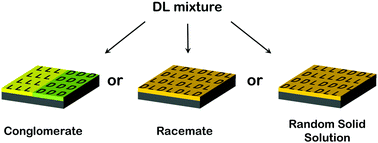当前位置:
X-MOL 学术
›
Chem. Soc. Rev.
›
论文详情
Our official English website, www.x-mol.net, welcomes your
feedback! (Note: you will need to create a separate account there.)
Enantiomer surface chemistry: conglomerate versus racemate formation on surfaces
Chemical Society Reviews ( IF 40.4 ) Pub Date : 2017-11-22 00:00:00 , DOI: 10.1039/c7cs00555e Soham Dutta 1, 2, 3, 4 , Andrew J. Gellman 1, 2, 3, 4, 5
Chemical Society Reviews ( IF 40.4 ) Pub Date : 2017-11-22 00:00:00 , DOI: 10.1039/c7cs00555e Soham Dutta 1, 2, 3, 4 , Andrew J. Gellman 1, 2, 3, 4, 5
Affiliation

|
Research on surface chirality is motivated by the need to develop functional chiral surfaces for enantiospecific applications. While molecular chirality in 3D has been the subject of study for almost two centuries, many aspects of 2D chiral surface chemistry have yet to be addressed. In 3D, racemic mixtures of chiral molecules tend to aggregate into racemate (molecularly heterochiral) crystals much more frequently than conglomerate (molecularly homochiral) crystals. Whether chiral adsorbates on surfaces preferentially aggregate into heterochiral rather than homochiral domains (2D crystals or clusters) is not known. In this review, we have made the first attempt to answer the following question based on available data: in 2D racemic mixtures adsorbed on surfaces, is there a clear preference for homochiral or heterochiral aggregation? The current hypothesis is that homochiral packing is preferred on surfaces; in contrast to 3D where heterochiral packing is more common. In this review, we present a simple hierarchical scheme to categorize the chirality of adsorbate–surface systems. We then review the body of work using scanning tunneling microscopy predominantly to study aggregation of racemic adsorbates. Our analysis of the existing literature suggests that there is no clear evidence of any preference for either homochiral or heterochiral aggregation at the molecular level by chiral and prochiral adsorbates on surfaces.
中文翻译:

对映异构体表面化学:表面上的团聚体与外消旋体形成
对表面手性的研究的动机是需要开发对映体专用的功能性手性表面。尽管将近3个世纪以来,3D分子的手性研究一直是研究的主题,但2D手性表面化学的许多方面仍有待解决。在3D中,手性分子的外消旋混合物往往比团聚体(分子同手性)晶体更频繁地聚集成外消旋体(分子异手性)晶体。尚不清楚表面上的手性吸附剂是否优先聚集成杂手性域而不是同手性域(2D晶体或簇)。在本次审查中,我们已首次尝试根据可用数据回答以下问题:在吸附在表面上的2D外消旋混合物中,纯手性或异手性聚集有明显的偏爱吗?当前的假设是在表面上优选手性堆积;与3D相比,异手性填充更为普遍。在这篇综述中,我们提出了一个简单的分层方案来对吸附物-表面系统的手性进行分类。然后,我们主要使用扫描隧道显微镜来研究外消旋被吸附物的聚集,从而回顾工作的主体。我们对现有文献的分析表明,没有明显的证据表明表面上的手性和前手性吸附物在分子水平上更倾向于同手性或异手性聚集。我们提出了一个简单的分级方案,对吸附物-表面系统的手性进行分类。然后,我们主要使用扫描隧道显微镜来研究外消旋被吸附物的聚集,从而回顾工作的主体。我们对现有文献的分析表明,没有明显的证据表明表面上的手性和前手性吸附物在分子水平上更倾向于同手性或异手性聚集。我们提出了一个简单的分级方案,对吸附物-表面系统的手性进行分类。然后,我们主要使用扫描隧道显微镜来研究外消旋被吸附物的聚集,从而回顾工作的主体。我们对现有文献的分析表明,没有明显的证据表明表面上的手性和前手性吸附物在分子水平上更倾向于同手性或异手性聚集。
更新日期:2017-11-22
中文翻译:

对映异构体表面化学:表面上的团聚体与外消旋体形成
对表面手性的研究的动机是需要开发对映体专用的功能性手性表面。尽管将近3个世纪以来,3D分子的手性研究一直是研究的主题,但2D手性表面化学的许多方面仍有待解决。在3D中,手性分子的外消旋混合物往往比团聚体(分子同手性)晶体更频繁地聚集成外消旋体(分子异手性)晶体。尚不清楚表面上的手性吸附剂是否优先聚集成杂手性域而不是同手性域(2D晶体或簇)。在本次审查中,我们已首次尝试根据可用数据回答以下问题:在吸附在表面上的2D外消旋混合物中,纯手性或异手性聚集有明显的偏爱吗?当前的假设是在表面上优选手性堆积;与3D相比,异手性填充更为普遍。在这篇综述中,我们提出了一个简单的分层方案来对吸附物-表面系统的手性进行分类。然后,我们主要使用扫描隧道显微镜来研究外消旋被吸附物的聚集,从而回顾工作的主体。我们对现有文献的分析表明,没有明显的证据表明表面上的手性和前手性吸附物在分子水平上更倾向于同手性或异手性聚集。我们提出了一个简单的分级方案,对吸附物-表面系统的手性进行分类。然后,我们主要使用扫描隧道显微镜来研究外消旋被吸附物的聚集,从而回顾工作的主体。我们对现有文献的分析表明,没有明显的证据表明表面上的手性和前手性吸附物在分子水平上更倾向于同手性或异手性聚集。我们提出了一个简单的分级方案,对吸附物-表面系统的手性进行分类。然后,我们主要使用扫描隧道显微镜来研究外消旋被吸附物的聚集,从而回顾工作的主体。我们对现有文献的分析表明,没有明显的证据表明表面上的手性和前手性吸附物在分子水平上更倾向于同手性或异手性聚集。










































 京公网安备 11010802027423号
京公网安备 11010802027423号